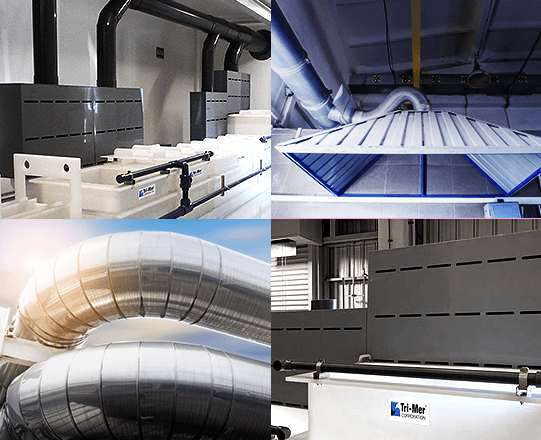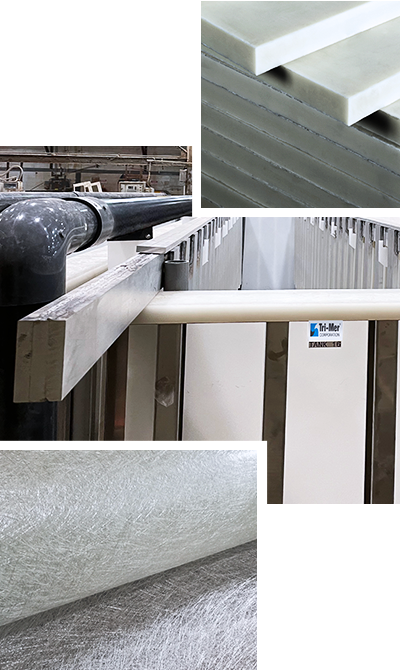Exhaust Hoods and Ventilation

Expert Solutions for Open Source Tanks
Companies often ask Tri-Mer for advice on exhaust hoods and ventilation strategies. Sometimes, a new process or chemistry has been installed. Even a change in process temperature, concentration or agitation can affect exhaust and how it's managed.
In other instances, the addition of new process stages – or PEL thresholds that are lower than before – are what prompt an examination of facility ventilation.
In one case, new parts handling equipment obstructed airflow that had been adequate. A modification in facility make-up air is also reason to take a fresh look at ventilation. Other reasons include signs of corrosion on facility assets – or equipment that seems to need repair more than usual.
Tri-Mer ventilation and exhaust specialists have more experience with more types of ventilation and exhaust hoods for industry, and can assist with related equipment for the control of gas emissions and particulate as well.
System Types
Techniques for exhausting open surface tanks fall into four main categories: Lateral exhaust, Push-pull, Canopy, and Enclosing
Lateral exhaust uses a slotted hood installed at a right angle and adjacent to the work zone to pull emissions across the surface of a tank. Source size, hazard class and the presence (or absence) of cross-drafts are factors that determine the quantity, height, and configuration of exhaust hoods. In cases where the draft distance exceeds 4 feet, lateral exhaust alone is often insufficient.

Push-pull employs a jet of air above the surface of the exhaust source, and a lateral exhaust hood, on opposite sides of the tank. A curtain of air sweeps the tank surface, forming a sheer layer on both sides of the jet. This slows the fluid in the jet and accelerates the ambient fluid. With a push-pull system, the tank walls and contents inhibit fluid entrainment on the low side of the jet, deflecting it toward the surface.
Push-pull ventilation requires significantly lower exhaust volumes versus lateral hoods, which work using exhaust alone. A push-pull system’s lower ventilation rates translate to smaller exhaust ducts, exhaust fans and scrubbers.
Exhausted air needs to be replaced and conditioned, and push-pull systems are often paired with makeup-air units.
Make-up air creates positive or negative pressure, depending on whether make-up air volume is more or less than the exhaust air. ANSI Z9.1 specifies that make-up air must be 90 to 110% of the exhaust air. If exhausts are hazardous, make-up air can’t exceed 100% of the exhaust.
Depending on the chemistry, unheated outside air can sometimes be directed over a tank to compensate for exhaust air. Where a process solution is cooled, unheated supply air can reduce cooling requirements.
Push-pull is most often used with large tanks, in applications where high capture efficiency is critical, and where access or ergonomic considerations preclude the use of an overhead canopy.

Canopy hoods can be free-standing and open on each side, or open on just three sides. They control airflow directly in applications with sufficient control velocity, but are not appropriate where highly toxic chemicals involved, or where thermal currents from hot processes, spot cooling or machinery motion create cross-drafts.
Canopy hoods are rarely used to ventilate open surface tanks for several reasons:
- Hoods placed directly above process tanks can interfere with hoists and other equipment
- Fumes directed vertically from the surface of the solution into an exhaust hood are likely to travel past an operator’s breathing zone.
Enclosing hoods partially or completely surround the tank. They consist of a lateral hood and panel(s) at each end. This ventilation option reduces cross-drafts by directing most of the hood airflow above the tank’s surface.
Enclosing hoods become impractical when operators require tank access.
Materials
Exhaust equipment for industry involving corrosive chemical compounds is most often manufactured in thermoplastic materials, as long as temperatures are below the threshold. Polypropylene (“PP”) is the most frequently specified material; options include PVC, PVDF, CPVC and alloys. Of these, PP and PVC are the most common.
- “Polyro” is stiff and rigid, with strong resistance to impact, stress fatigue, and temperature extremes. It is highly resistant to corrosion and chemical leaching, making it a worthy companion for solvents, bases and acids. It’s a wise choice for facilities with cranes, forklifts and other powered equipment because it is impact resistant and can be repaired on-site. PP also holds a load well at higher temperatures.
- When ethylene is combined with the propylene during the polymerization process, the result is polypropylene copolymer. This material has increased flexibility and improved optical properties.
- PVDF has excellent piezoelectric properties, thermal stability, and mechanical strength. Hoods manufactured from PVDF have excellent resistance to acids, bases, organic solvents, oils, and fats, and exceptional insulating properties; the material is also self-extinguishing.
- PVDF is highly recommended where one or more process stages are held at elevated temperatures.
- PVC has high density for a plastic material, so it’s extremely strong, as well as lightweight and economical. PVC’s operating peak is 140°F; CPVC can handle up to 200°F.

Ventilation is a critical engineering control that directly affects everyone — and everything — in a shop. Whether you’re planning a new line, expanding an existing one, considering new chemistry, or building an R&D lab, getting input from a company that offers a broad range of ventilation and exhaust solutions will make you smarter — and likely save you many dollars in the short and long term.
This form is the fastest way to get in touch with us.
A more detailed form, located here, will tell us what we need to generate a detailed quote.





